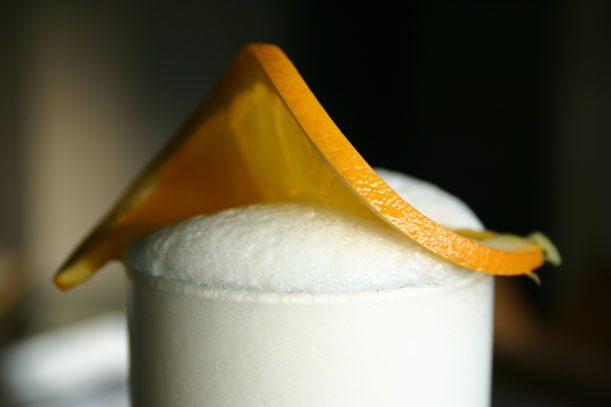
The Ramos gin fizz gets its frothy top from several minutes of vigorous shaking. Photo by Flickr user ReeseCLloyd
Read on for five famous cocktails and the literary moments they inspired:
Ramos Gin Fizz
The Ramos gin fizz is a New Orleans classic invented in 1888 by Henry C. Ramos of the Imperial Cabinet Saloon. The recipe calls for egg white, flower water, dairy and vigorous shaking for three to ten minutes. The drink became so popular in the 1910s that Ramos had to employ 20 to 30 “shaker boys” to keep up with demand. Despite its long prep time, the gin fizz is meant to be consumed quickly, especially as a cool refreshment on a hot summer day.
On one of histrips to New York, Louisiana “Kingfish” Huey Long had a bartender flown in from the Roosevelt Hotel in New Orleans, he said, to “teach these New York sophisticates how and what to drink.”
In Walker Percy’s Love in the Ruins, Dr. Thomas More defies his egg white allergy by downing gin fizz after gin fizz with Lola, his lover. “These drinks feel silky and benign,” he muses—until seven fizzes later, he breaks out in hives and his throat starts to close. More’s brush with death mirrors Walker Percy’s own: the writer once went into anaphylactic shock after drinking gin fizzes with (luckily for him) a Bellevue nurse. Percy later wrote in his 1975 essay, “Bourbon”: “Anybody who monkeys around with gin and egg white deserves what he gets. I should have stuck with Bourbon and have from that day to this.”
(The recipe below, along with all the others in this post, is courtesy of Philip Greene, co-founder of the Museum of the American Cocktail and author of To Have and Have Another: A Hemingway Cocktail Companion. Greene recently hosted the Smithsonian Associates seminar, “Literary Libations.”)
1 ½ oz Citadelle gin
½ oz fresh lemon juice
½ oz fresh lime juice
1 tsp sugar or ½ oz Fee Brothers rock candy syrup
1 oz half and half or cream
3 drops Fee Brothers orange flower water
1 egg white (pasteurized optional)
Place ingredients in a shaker with
cracked ice. Shake vigorously for 2-3 minutes. Strain into a chilled
Delmonico or short Collins glass. Top off with 1-2 oz seltzer water.
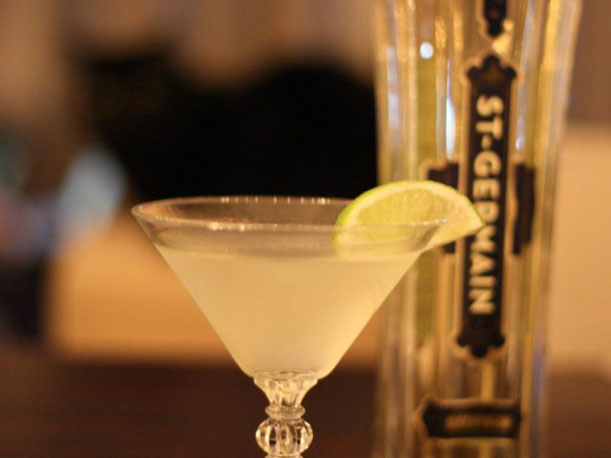
A
traditional gimlet contains gin and Rose’s lime cordial, but today the
drink is often made with vodka and fresh lime juice. Photo by Flickr
user Kenn Wilson
Lennox’s one-to-one ratio is too sweet for most modern drinkers. These days, gimlets are typically made with fresh lime juice instead of Rose’s syrupy cordial (and with vodka instead of gin). But Rose’s did have an edge in shelf life: as seen in Green Hills of Africa and The Short Happy Life of Francis Macomber, Ernest Hemingway opted for gimlets on safari, probably because Rose’s was less likely to spoil.
Legend has it that the gimlet was named after Dr. Thomas Gimlette of the Royal British Navy, who used the citrusy drink to stave off sailors’ scurvy—or after the device, called a “gimlet,” used to bore holes in lime juice casks.
2 oz Hendrick’s gin
1 oz Rose’s lime juice
Shake on ice until well chilled. Strain into a cocktail glass. Garnish with a lime wedge or wheel.
Brandy Alexander
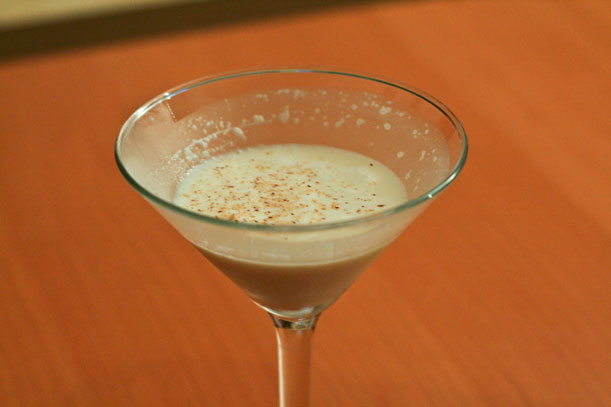
Made with cream and chocolate liqueur, the brandy Alexander is basically an alcoholic milkshake. Photo by Flickr user ImipolexG
The brandy Alexander also figures in Who’s Afraid of Virginia Woolf?, Edward Albee’s nightmare portrait of marital dysfunction. The drink takes George and Martha back to a more innocent time in their relationship, when the latter would order “real ladylike little drinkies” including brandy Alexanders and gimlets. “But the years have brought to Martha a sense of essentials,” says George, “the knowledge that cream is for coffee, lime juice for pies … and alcohol pure and simple … here you are, angel … for the pure and simple. For the mind’s blind eye, the heart’s ease, and the liver’s craw. Down the hatch, all.”
1 ½ oz brandy
1 oz cream
1 oz crème de cacao (brown)
Shake with ice. Strain into a cocktail glass. Garnish with a sprinkle of nutmeg.
Whiskey Sour
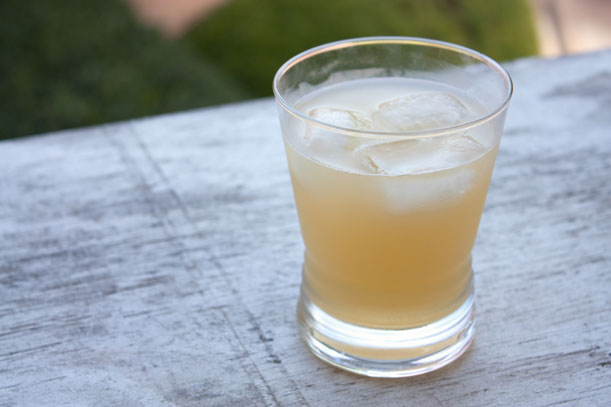
Ernest
Hemingway once tried to cure F. Scott Fitzgerald with a “lemonade and a
whisky,” his term for a whiskey sour. Photo by Flickr user Mitchell Bartlett
Hemingway was an up-and-coming writer, and Fitzgerald a literary star, when the two first met in France in 1925. According to Hemingway’s memoir, Fitzgerald became hysterical one night after having too much wine. He worried that he would die from “congestion of the lungs” and wondered aloud who would take care of his wife Zelda and daughter Scottie. Hemingway recalled trying to calm him down: “If you want to do the best thing to keep from catching cold, just stay in bed and I’ll order us each a lemonade and a whisky. . .” Hemingway was irritated by the whole “silliness,” but said that “you could not be angry with Scott any more than you could be angry with someone who was crazy. . . it was hard to accept him as a drunkard, since he was affected by such small quantities of alcohol.”
Whiskey sours also make an appearance in Thomas Pynchon’s The Crying of Lot 49 (1966). The novel opens with Oedipa Maas going through the motions of her dull life as a housewife—Tupperware parties, Muzak, lasagna making and the “mixing of the twilight’s whiskey sours against the arrival of her husband.” But it’s the whiskey sour that makes the cut in John Crace’s satirical “digested read” of the novel, indicating that the drink was especially emblematic of Maas’s domestic malaise.
1 ½ to 2 oz. Wild Turkey bourbon
½ oz Fee Brothers rock candy syrup
Splash water
½ oz fresh lemon juice
Shake well with ice, strain into a chilled cocktail glass.
H.L. Mencken once wrote that the origin of the Bronx cocktail was “unknown to science” (“all that is known is that it preceded the Bronx Cheer”), but a popular story credits Johnnie Solon, famed bartender of the Waldorf-Astoria, with inventing the drink circa 1900. Solon reportedly named the Bronx cocktail after the Bronx Zoo: “I had been at the Bronx Zoo a day or two before, and I saw, of course, a lot of beasts I had never known. Customers used to tell me of the strange animals they saw after a lot of mixed drinks. So when Traverson [head waiter of the dining room] said to me, as he started to take the drink in to the customer, ‘What’ll I tell him is the name of this drink?’ I thought of those animals, and said: ‘Oh, you can tell him it is a “Bronx.”‘”
The Bronx cocktail caught on in the 1910s and ’20s, rivaling the Manhattan and the martini in popularity. In F. Scott Fitzgerald’s The Great Gatsby, orange juicing is mechanized at the Gatsby mansion to keep up with Bronx cocktail demand: “Every Friday five crates of oranges and lemons arrived from a fruiterer in New York—every Monday these same oranges and lemons left his back door in a pyramid of pulpless halves. There was a machine in the kitchen which could extract the juice of two hundred oranges in half an hour if a little button was pressed two hundred times by a butler’s thumb.” And in This Side of Paradise, Amory Blaine consoles himself with a round of Bronxes after getting dumped by Rosalind.
In his 1940 autobiographical work Dusk of Dawn, W.E.B. Du Bois draws a caricature of a hypocritical white minister as a well-bred man in Brooks Brothers clothes who “plays keen golf, smokes a rare weed and knows a Bronx cocktail from a Manhattan.” For the record, the main difference between the two cocktails is the liquor—a Bronx is made with gin and a Manhattan with rye. But, according to the 1934 film version of Dashiell Hammett’s The Thin Man, the “important thing is the rhythm. . . . a Manhattan you always shake to fox-trot time, a Bronx to two-step time. . .”
1 ½ oz Citadelle gin
½ oz Martini sweet vermouth
½ oz Noilly Prat dry vermouth
½ oz orange juice
Shake well and strain into a chilled cocktail glass.
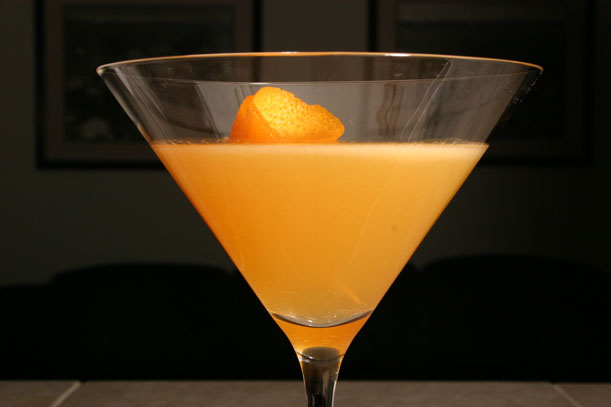
No comments:
Post a Comment